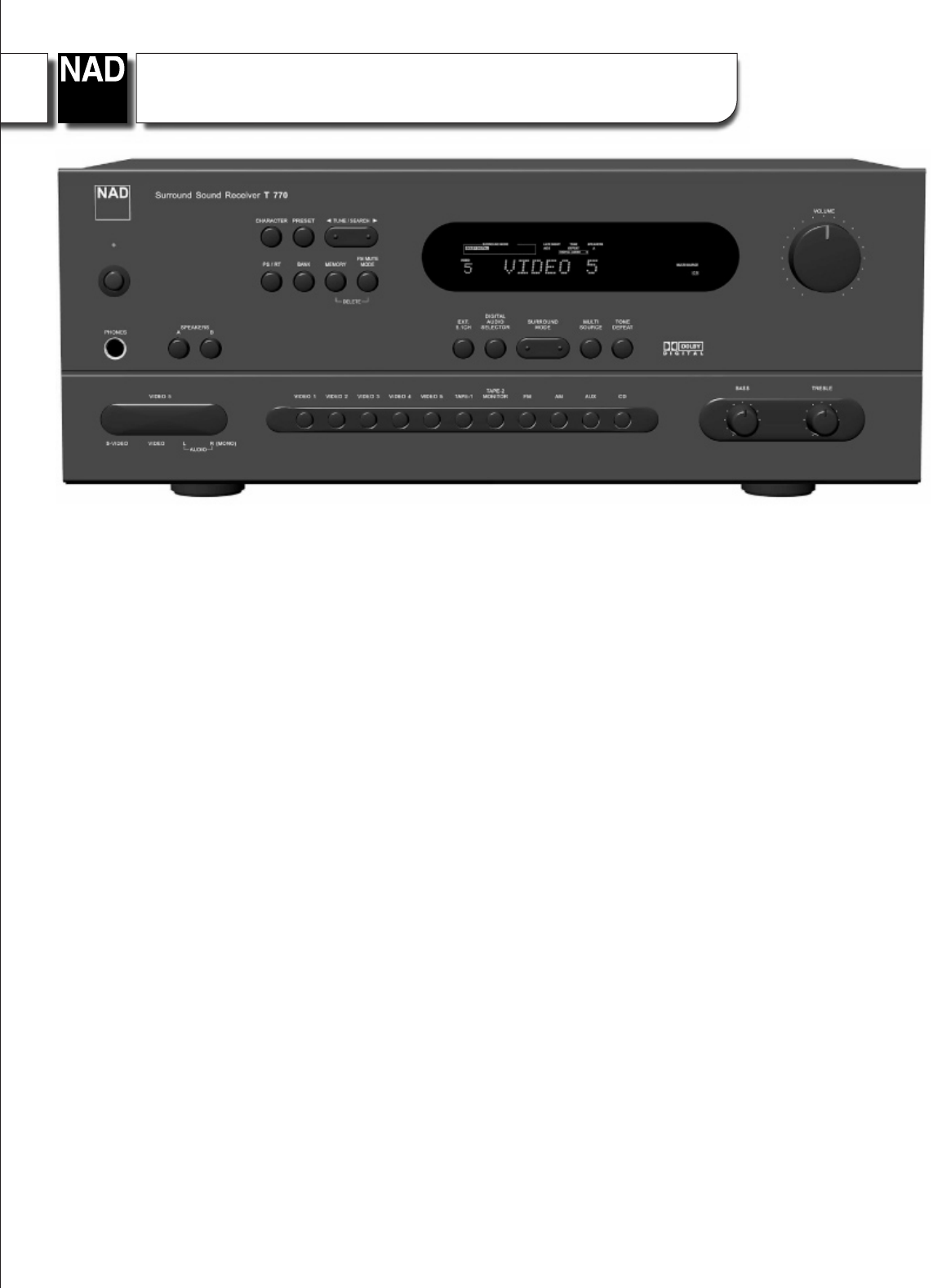
T770 Surround Sound Receiver
• 5 x 70 Watts • Up to of 40 amps peak current capability
• Dolby Digital decoder integrated • Motorola 56009 and 56004 DSP processors
• Burr-Brown DACs with 18 bit resolution • 5.1 input for external decorder
• Pre-outs for all 5 channels • Subwoofer output • Impedance Sensing Circuitry (ISC)
• 4 Audio inputs; 2 tape outputs • 5 Video inputs; 2 video outputs
• 3 digital inputs • EARS (Enhanced Ambience Recovery System) surround mode
• Tone Defeat • Gold Plated Sockets throughout • 30 presets
• Soft Clipping • System Remote Control • NAD-Link
Most A/V receivers available on the market today focus predominantly on
the Video and Surround Sound aspects, leaving audio circuitry almost
as an afterthought. NAD firmly believes that there are many people for
whom music will always come first so. With NAD’s reputation for high value
/high performance it was obvious that the Model T770 would have to
please Audiophiles and Videophiles alike.
Design
By doing away with many costly and superfluous features, NAD’s engineers
concentrated only on the truly important parts of an A/V receiver. As the
new Digital Surround Sound formats allow for the same wide bandwidth
and large dynamic range for the rear channels as the rear channels, all five
channels are capable of putting out an equal amount of power. As usual
with NAD, the T770 uses discrete output stages only, including the
surround channels. The benefits of this approach have been proven over
the years in many acclaimed NAD amplifiers and receivers. The integrated
output modules favored by so many other designs will deliver a decent
amount of power under laboratory conditions, driving an 8 ohms resistor,
but can have great difficulties in driving real world loudspeakers.
Impedance Sensing Circuitry (ISC)
The new Impedance Sensing Circuitry (ISC) topology designed by Bjørn
Erik Edvardsen allows the T770 to deliver maximum performance under
virtually any circumstance, independent of the loudspeakers it is driving.
The circuitry automatically recognizes the impedance characteristics of the
loudspeaker and will then adjust its power supply settings to best cope with
that specific load.
NAD takes a stance to the mindless “brochure power” approach which doesn’t
give a realistic indication of an amplifier’s true capabilities. Instead, the ISC
topology is a practical approach to enable an amplifier to easily deal with
dynamics and difficult loads. More meaningful are the T770’s dynamic
capabilities; up to 300 Watts into 2 ohms and up to 40 amps current capability.
Whereas it is widely accepted with CD players that the digital and analog
circuitry play a vital role in the performance, it appears that many AV
receivers employ only mediocre signal conversion and processing
circuits. For the T770 the engineers choose the best available within the
budget: Burr-Brown DACs with 18-bit resolution. The two DSP chips that
handle the Dolby Digital, Dolby Pro Logic, EARS and other Surround
Modes chosen, are from the well renowned Motorola 56000 family. The
combination of these components ensure that the integrity of the original
signal retains its full resolution and dynamics.
Flexibility
As one would expect from any NAD component, the Model T770 offers
great flexibility; 5 video and 4 audio inputs allow you to connect all your
sources with ease. All video in and outputs are S-Video and Composite
compatible, including the video input on the front panel.
Besides these "normal" inputs, the T770 also sports an external decoder
(5.1 channel) input so you can easily expand your receiver in the future
with an outboard decoder for another surround sound format, such as DTS,
for instance. 3 Digital inputs are provided, to cater for every eventuality:
A coaxial digital input, an input with a RF demodulator integrated and a TOS
Link for sources with optical outputs. Whether it' a Laserdisc, CD and/or
DVD player, the T770 will connect to it. With pre-amplifier outputs for all
channels you can easily upgrade your output power too.
To ensure long-term contact reliability, all speaker terminals are of the
robust binding post variety rather than the usual spring clips and all other
audio sockets are gold plated.
The remote control handset supplied with the Model T770 also has controls
for NAD CD players or changers and a (dubbing) cassette deck. With NAD
Link it is possible to remote control other NAD products which do not have
their own remote control (NAD Cassette Deck Model 616, for instance )
from the T770’s remote control.




